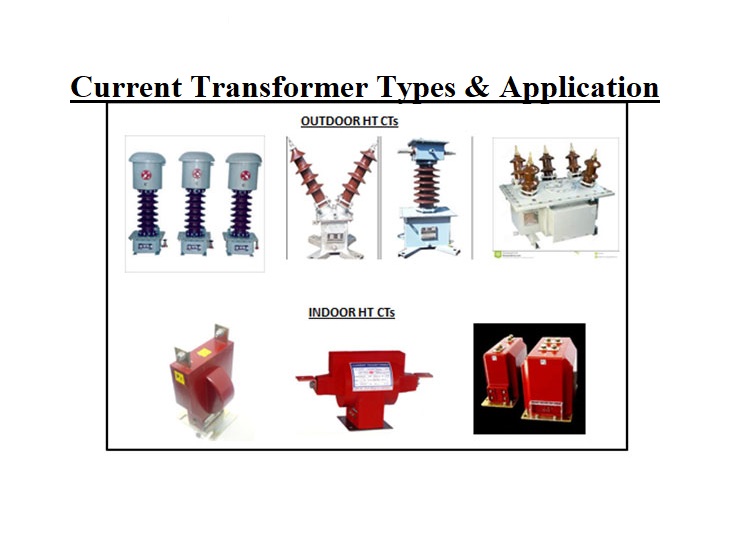Current Transformer Types and Applications- Current transformers (CT) are employed in Medium-Voltage (MV) and High-Voltage (HV) installations to give an image of electrical output to protection units and relays and metering instruments. They are constructed to supply a current in its secondary winding related to the current flowing in its primary winding. In our other post, we explained the main principles of a current transformer design and performance. Now we will present a few of the practical current transformer types and applications.
What is a Current Transformer?
The transformer is an electrical instrument employed to transmit electric energy from one circuit to another without varying its frequency, and it can obtain by electromagnetic induction. Fundamentally, transformers are present in two forms, namely core type and shell type. The basic operation is to step down and step up the voltage.
Instrument transformers are utilized for measurement purposes since these transformers measure voltage, current, power, and energy. These are used in several devices with a conjunction like an ammeter, voltmeter, wattmeter, and energy meter. These transformers are categorized into two main kinds, namely the potential transformer and the current transformer. In this post, we will discuss the definition, types, and applications of the current transformers completely.
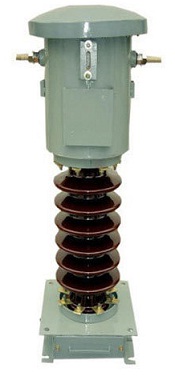
An instrument transformer that is used to produce an AC (Alternating Current) across the secondary section of the transformer is introduced as a current transformer. This is also introduced as a series transformer as it is configured in series form with the circuit for sensing various parameters of electric power. Here the current in the secondary section is related to the current in the primary one. These are mainly utilized to decrease high-voltage currents to low-voltage outputs.
Working Principle of a Current Transformer
The working principle of a current transformer is somewhat different when measuring it with a standard voltage type of transformers. It contains two windings similar to the normal voltage transformer. Whenever AC is provided throughout the primary section, then alternating magnetic flux can be produced, then AC will be stimulated across the secondary section. In this form, the load impedance is very low. Therefore, this device operates under short-circuit situations. So, the current through the secondary section is based on the current in the primary winding but is not based on the load impedance.
Current Transformer Types
Current transformers types are several in the market. In this post, we will present the main types of them. Current transformers are classified into four main types, which contain the following:
Indoor Current Transformer
Indoor current transformers are commonly used in low-voltage circuits. They themselves are divided into different forms such as window, wound, and bar. Wound type consists of two windings, including primary and secondary similar to the basic type. These are employed in summing cases because of their high accuracy and high values of primary ampere turns.
The bar-type instrument contains bar primary with secondary cores. In this form, bar primary is an important part. The accuracy of this device can be decreased due to the magnetization effect in the core. Window form can be set in the region of the primary conductor since the modeling of these transformers can be performed without primary winding.
These forms of transformers exist in split-core and solid designs. The primary conductor must be detached before connecting this form of transformer, whereas, in split-core, it can set straightly in the section of the conductor without separating it.
Outdoor Current Transformers
Outdoor current transformers are employed in high-voltage circuits such as switchyards and substations. These are present in two forms introduced as SF6 gas insulation and oil-filled. SF6 insulated form of current transformers is lightweight once we contrast them with oil-filled form transformers.
The pinnacle tank can be attached toward the primary section, which is introduced as a live tank construction form of the current transformer. In this structure, small bushings are applied since both the primary conductor, and the tank are at the same capacity. The split type primary winding is utilized for multi-ratio CTs.
Therefore, taps are configured on the tank intended for the primary section, so the variable current rate can be achieved by using these devices. When the taps are provided to the secondary winding, then the working ampere-turns can be modified while provided to the primary section, so the unexploited copper gap can be left excluding in the lowest level.
Bushing Current Transformer
This type of transformer is similar to the bar form, where the secondary section and core are installed in the section of the primary conductor. The secondary section in the transformer can be twisted into a circular dissimilar to the annular-shaped core. It is attached to the high-voltage bushing across the power transformers, circuit breakers, switchgear otherwise generators.
When the conductor flows all over the bushing, then it operates as a primary winding, and the configuration of the core can be performed by enclosing an insulating bush. These forms of current transformers are employed in the high-voltage systems for relaying aims since these are not expensive.
Portable Current Transformers
These forms of transformers are high accurate kinds mostly employed for power analyzers and high precision ammeters. These transformers are existence in several types like clamp ON portable, flexible, and split-core. The measurement of the current level for the portable form of current transformer types differs from 1000A to 1500 A. These devices are commonly used to supply the isolation for the sensing instruments from the circuits with large voltage. Visit here to know the current transformer types completely.
In addition to the four main types discussed before, there are other current transformer types, including:
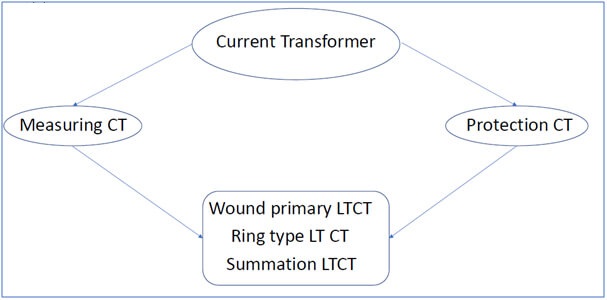
Standard Measuring Current Transformer
Standard measuring current transformers are employed in combination with ammeters to control high currents, which are stepped down to a normal output level of either 1 A or 5 A. The V.A state of the current transformer is matched with the V.A level of the sensing instrument or ammeter.
A 200/5 FSD form (Full-Scale Deflection) of the current transformer is employed in combination with a turning iron ammeter with a rating from zero to 200 A. The ammeter is identified by calibration so that FSD happens once the output of the current transformer is 5 A.
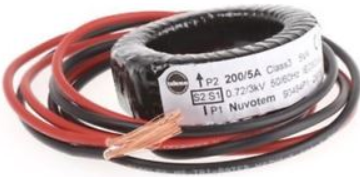
The burden R of the device must be small as possible to provide close to short a circuit to ensure the non-obstructed secondary output. Burden R employed in combination with a voltmeter must also be as small as feasible to keep the current transformer’s secondary voltage small for increased precision.
Standard V.A ratings of normal measuring CTs are 10, 5, and 2.5 V.A. It is essential for measuring devices to saturate at a ratio that guarantees the safety of the measuring device at a higher-than-rated output or under-fault situations.
If the ammeter is eliminated from the system, the secondary winding completely becomes open-circuited, and the device performs as a step-up transformer. This due in part to the very high increase in the magnetizing environment in the current transformer’s core since there is no opposing output in the secondary section to prevent this.
This can cause a very large voltage being stimulated in the secondary winding as same as the ratio of Vp (Ns/Np) being improved through the secondary winding. For this reason, a current transformer should never be in open-circuited condition. If the load (or ammeter) should be removed, a short-circuit must be installed close to the secondary terminals first to reduce the risk of shock.
Metering Current Transformer
A metering current transformer is constructed to sense the current continuously and operate precisely within the rated current level. Phase displacement limits and current error are identified by the accuracy class. Accuracy classes include 0.1, 0.2, 0.5, and 1.
In energy meters, wattmeters, and power factor meters, phase shift makes errors. Although, the explanation of electronic energy and power meters has allowed the current phase error to be calibrated out.
When the current exceeds the standard level, the metering CT will saturate, thereby restricting the current rate through the instrument. Core substances for this kind of current transformers typically have a small saturation level, such as nanocrystalline.
Nuvotem AP forms and AQ forms are accurate current transformers with normal precision of 0.1–0.2%, making them desirable for cases needing high precision and at least phase displacement.
Protection Current Transformer
A protection current transformer is modeled to perform well into the overcurrent state. This enables the particular relays to control the fault currents precisely, even in very high current situations. The secondary output is employed to run a protective relay which can isolate the section of the energy circuit experiencing a fault state. Core material for this type of CT has a high saturation level and is normally made from silicon steel.
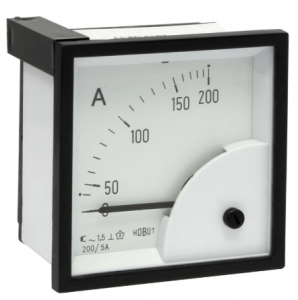
Wound Primary
In this form, the primary winding is practically configured in series form with the conductor that controls the current. The primary section includes a single turn and is composed inside the device. Wire wound of current transformer types can be employed to sense the currents in the range of 1A to 100A.
Bus Bar
In this form, the bus bar of the basic circuit itself performs as the primary section with a single turn. So, the bar transformer includes just secondary windings. The body of the current transformer itself supplies insulation between the ground and the primary circuit. Such transformers can be used at the highest transmission voltages by using oil insulation and porcelain bushings.
Ring Type
In this form, the current transformer is set over a bus bar or an insulated wire, and just a low rating of insulation is existence on the secondary coil. To achieve non-standard levels or for other particular purposes, more than one twist of the primary wire should be passed across the ring. The core is commonly laminated silicon steel, and the windings are made of copper.
Summation
Summation transformers are employed for comparing the relaying values derived from the output in the three phases of the primary section. This is performed by transforming the three-phase values into the single-phase quantity. The line current transformers are attached to the primary section of the auxiliary current transformer. These instruments are applied for ensuring the appropriate functioning of relay circuits.
Read More on Linquip
- Efficiency of Transformer
- What is Potential Transformer?
- What is the Current Transformer?
- What is Power Transformer?
- working principle of transformer: discover the mechanism involved in the operation
Errors in Current Transformer Types
The errors that happened in different current transformer types include the following:
- The primary section of the transformer needs MMF (magnetomotive force) to produce flux which draws a magnetizing current in the system.
- The transformer’s no-load output contains an element of core waste component and results in hysteresis and eddy current wastes.
- While the device’s core is saturated, then the magnetizing load’s flux density can be ceased, and other wastes can happen.
How to Choose the Right Current Transformer Between Different Types?
The following features should be considered before selecting the best current transformer for an application:
- Rated primary current
- The voltage of the circuit
- Rated Secondary current
- Rated load on Secondary side
- Accuracy Class Rating
This selection should also be made considering the maximum intensity of the primary circuit and the conductor profile.
Applications of a Current Transformer
The two major application fields of current transformers are current measurement and protection. They are also employed for isolation between measuring instruments and high-voltage power networks. This not only guarantees the safety of the user but also of the end instrument in use. It is recommended to employ current transformers for applications of 40A or larger.
Current Transformer in Measurement
A metering current transformer is constructed to sense the current on a continuous foundation. These current transformer types operate with a great degree of precision but within the rated current level. Metering current transformers include a primary section to which the current to be detected is fed. Measuring devices are attached to a secondary section. This makes them suitable to be employed in combination with other measurement devices and power detecting products – from simple power meters to energy meters such as:
- Ammeters
- Kilowatt-hour meters
- Measurement units
- Control relays
Current Transformers in Power Protection System
A protection current transformer is employed to decrease the currents in power networks, thereby protecting them from failures. These current transformer types sense the actual current in the primary winding and generate proportionate outputs in their secondary sides, which are entirely isolated from the primary circuit.
This output current is then employed as an input to a protective part, which will automatically isolate that relay of the power circuit in case of a break-down. Because only the faulty part is isolated, the rest of the configuration can continue to perform normally.
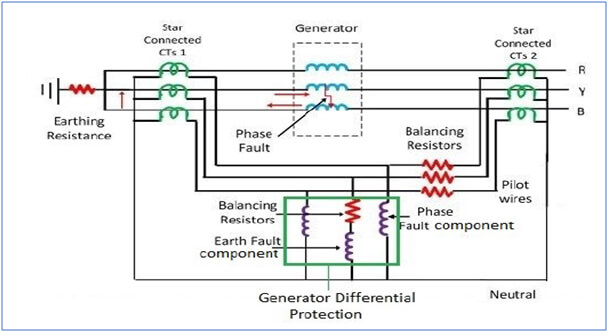
Some of the important application cases where current transformer types are used are:
- Control the high-voltage electrical sub-stations and the electrical grid
- Activation the protective relay in case of a failure current and isolate a component of or the full system from the main supply
- Commercial metering
- Differential Protection, Earth fault Protection, and Bus–bar protection system
- Motor and generator sets
- Control Panel (APFC, VCB, MCC, AMF, PCC, and Relay panels) and Drives
- Standard types for laboratory purpose
- Bushing type, oil-immersed CT in Power transformer
- Current sensing, monitoring, recording, and control
Buy Equipment or Ask for a Service
By using Linquip RFQ Service, you can expect to receive quotations from various suppliers across multiple industries and regions.
Click Here to Request a Quotation From Suppliers and Service Providers

